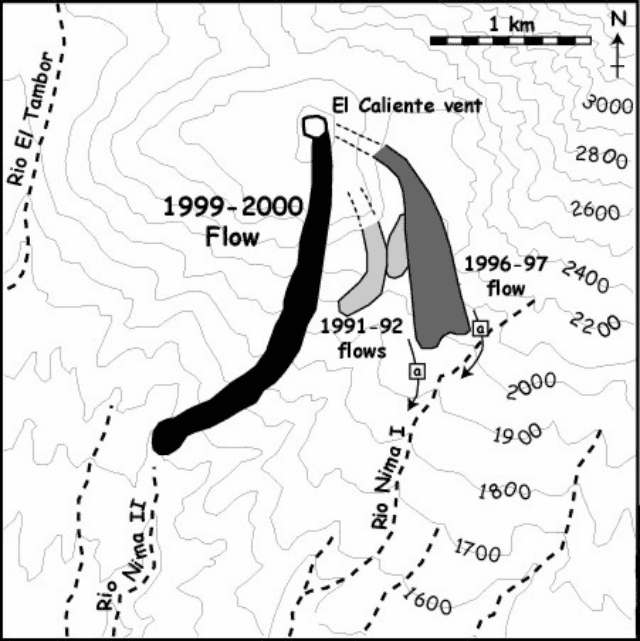Report on Santa Maria (Guatemala) — June 2000
Bulletin of the Global Volcanism Network, vol. 25, no. 6 (June 2000)
Managing Editor: Richard Wunderman.
Santa Maria (Guatemala) January 2000 lava flow goes 2.5 km down S flank
Please cite this report as:
Global Volcanism Program, 2000. Report on Santa Maria (Guatemala) (Wunderman, R., ed.). Bulletin of the Global Volcanism Network, 25:6. Smithsonian Institution. https://doi.org/10.5479/si.GVP.BGVN200006-342030
Santa Maria
Guatemala
14.757°N, 91.552°W; summit elev. 3745 m
All times are local (unless otherwise noted)
A blocky lava flow fed from the Caliente vent, active since July 1999 (see BGVN 24:12), had advanced nearly 2.5 km by the end of January 2000. The thermal anomaly related to this flow as measured on the 23 January Landsat 7 Enhanced Thematic Mapper (ETM+) is ~2,370 m long and 60-120 m wide. The flow extended S down the flank of the Santiaguito dome complex before being deflected SW by a low ridge and moving over the top of the 1986-89 flow (figure 29). A ~50 m-wide axial zone of the flow was very steep with a front slope of 60-70°. This ~30-m high axial zone advanced downward and collapsed into the sheer-sided ravine that forms the upper reaches of the Río Nimá II. The marginal flow front is ~18 m thick and its slope is smaller (~32°). As 2- to 5-m-wide sections of the flow front moved, minor collapses occurred at a rate of 1 to 2 per minute. Ash clouds generated by these collapses had temperatures of 185°C, and flow temperatures as high as 531°C were measured at a freshly exposed section of the axial zone. Temperatures for the blocky crust capping the flow front were lower, typically 34-76°C.
On 23 January, the Caliente vent was full. The 23 January ETM+ image shows this zone as an intense, thermal anomaly, 120-150 m in diameter. Small ash eruptions occurred at a rate of 1-2 events per hour producing ash plumes that extended kilometers above the vent. More powerful events generated small pyroclastic flows as well as rock falls. Both the dome and upper flow area collapse frequently produced audible rock falls that could be heard from a distance of ~1.5 km. Thirty-seven (37) rockfalls were heard on 23 January; 7 of which were incandescent as hot blocks from the dome and upper flow bounced down the flank of the dome.
Geological Summary. Symmetrical, forest-covered Santa María volcano is part of a chain of large stratovolcanoes that rise above the Pacific coastal plain of Guatemala. The sharp-topped, conical profile is cut on the SW flank by a 1.5-km-wide crater. The oval-shaped crater extends from just below the summit to the lower flank, and was formed during a catastrophic eruption in 1902. The renowned Plinian eruption of 1902 that devastated much of SW Guatemala followed a long repose period after construction of the large basaltic andesite stratovolcano. The massive dacitic Santiaguito lava-dome complex has been growing at the base of the 1902 crater since 1922. Compound dome growth at Santiaguito has occurred episodically from four vents, with activity progressing E towards the most recent, Caliente. Dome growth has been accompanied by almost continuous minor explosions, with periodic lava extrusion, larger explosions, pyroclastic flows, and lahars.
Information Contacts: Eddie Sánchez and Otoniel Matías, Instituto Nacional de Sismología, Vulcanología, Meteorología e Hydrología (INSIVUMEH), Ministerio de Communicaciones, Transporte y Obras Publicas, 7A Avenida 14-57, Zona 13, Guatemala City, Guatemala; Andy Harris and Luke Flynn, IGP/SOEST, University of Hawai'i, 2525 Correa Road, Honolulu, HI 96822, USA; Bill Rose, Department of Geological Engineering and Sciences, Michigan Technological University, Houghton, MI 49931, USA; James Vallance, Department of Civil Engineering and Applied Mechanics, McGill University, Montreal, Quebec H3A 2K6, Canada; Edouard Gegout, c/o European Volcanological Society, C.P.1-1211 Geneva 17, Switzerland.


